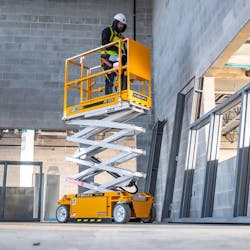Interview with Hy-Brid Lifts’ Justin Kissinger: Supply Chain Improvements

Justin Kissinger, marketing manager, Hy-Brid Lifts, talks about lithium batteries, demand from infrastructure spending and onshoring, supply chain improvements, growing acceptance of electric units, and more.
RER: What new equipment enhancements or developments has your company come up with in the past year?
Kissinger: We have launched a pipe rack, confined access platform, and lithium batteries for our lifts to increase operator safety, productivity, and return on investment. The pipe rack helps improve safety and productivity by providing a manufacture tested option to bring up to 100 pounds of pipe up to their working area. It was designed to sit on top of the side guardrail to minimize the amount of working space consumed from the option. We also developed a confined access solution which provides an additional 18.5 inches of access above the top of guardrails to safely access restricted areas. When not in use the confined access collapses down to the guardrail height so the lift can fit through standard doors.
Another option we introduced was lithium batteries to address one of the biggest industry issues of battery maintenance and life. Lithium batteries charge faster, run longer, require no maintenance, and have an estimated lifespan of over 10 years which significantly increases the lifts’ return on investment over the life of the lift.
Obviously, the trend towards electrification of equipment has accelerated in the past year. Are you finding greater interest and acceptance among your rental company customers? How about among end users?
Kissinger: In the slab scissor lift segment, electrification has been happening for a long time and is commonplace. When Hy-Brid Lifts was launched in 2004, we used electric drive and steering for our scissor lifts when other manufactures were focused on hydraulic systems. This reduced the amount of hydraulic oil needed and provided greater efficiency. A few years ago, we showed an all-electric scissor lift at The ARA Show to completely remove hydraulics. While there was customer interest, the pricing was a sticking point but with all new technology the price will eventually come down to an acceptable level to drive customer adoption.
Has the charging infrastructure improved for electric equipment on job sites?
Kissinger: By the time our lifts come on the jobsite there usually is adequate power to the site.
It appears that the coming year should be strong for aerial equipment sales. Do you expect to see a lot of opportunities in infrastructure spending? Increased industrial and/or non-residential work? An onshoring trend in North America?
Kissinger: Next year demand for aerial equipment will continue to be strong as the COVID-19 pandemic significantly disrupted the industry. At the start of the pandemic, companies delayed purchases which increased their fleet ages. Then when the industry
started opening up again, demand skyrocketed, and manufacturers encountered supply chain issues that delayed deliveries, keeping the fleets aged. Additionally, the infrastructure spending and onshoring will continue to increase equipment demands in all segments.
Are the supply chain issues still a major problem for your company and are lead times still long or are things more normal?
Kissinger: Supply chain issues have significantly improved for us. Suppliers are still cautious and not all of them have returned to full capacity, which has increased lead times for some components but all of that can easily be managed by operations to keep production on schedule. The supply chain improvements have allowed the lead times for our range of equipment to return close to normal.
Any there other trends in aerial equipment you expect to see in the near future?
Kissinger: Aerial equipment will continue to be electrified, not just drive systems but full electrification removing all hydraulics from the equipment as the technology matures to allow the cost to be justified. With electrification there will be more lithium batteries to reduce maintenance costs and more connectivity with telematics to increase productivity and service.
About the Author
Michael Roth
Editor
Michael Roth has covered the equipment rental industry full time for RER since 1989 and has served as the magazine’s editor in chief since 1994. He has nearly 30 years experience as a professional journalist. Roth has visited hundreds of rental centers and industry manufacturers, written hundreds of feature stories for RER and thousands of news stories for the magazine and its electronic newsletter RER Reports. Roth has interviewed leading executives for most of the industry’s largest rental companies and manufacturers as well as hundreds of smaller independent companies. He has visited with and reported on rental companies and manufacturers in Europe, Central America and Asia as well as Mexico, Canada and the United States. Roth was co-founder of RER Reports, the industry’s first weekly newsletter, which began as a fax newsletter in 1996, and later became an online newsletter. Roth has spoken at conventions sponsored by the American Rental Association, Associated Equipment Distributors, California Rental Association and other industry events and has spoken before industry groups in several countries. He lives and works in Los Angeles when he’s not traveling to cover industry events.